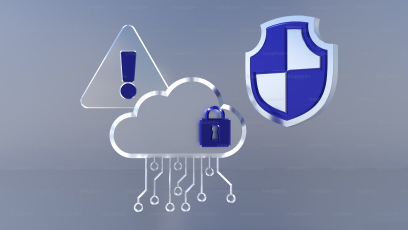Cybersecurity Challenges for Swiss SMEs in 2025 and How to Overcome Them

Nico Plapperer
Last updated October 20th, 2025

The digital landscape for Swiss small and medium enterprises (SMEs) is transforming rapidly in 2025. With increased digitalization, cloud adoption, and remote work integration, Swiss SMEs face a growing array of cybersecurity challenges. Cybercriminals continue to develop more sophisticated techniques to target businesses that often lack the extensive resources of larger corporations. As Swiss SMEs become more interconnected with global supply chains and digital ecosystems, protecting sensitive data and maintaining operational continuity requires proactive and strategic cybersecurity management.
This blog explores the key cybersecurity challenges Swiss SMEs are expected to face in 2025 and offers actionable strategies to help executives, IT managers, and business owners build resilience and safeguard their organizations.
1. Ransomware: Persistent and Expanding Threat
Ransomware remains among the most serious threats to Swiss SMEs in 2025. Attackers deploy malicious software to encrypt critical business files, demanding ransom payments to restore access. This attack type has become more targeted, with cybercriminals carefully selecting victims able to pay significant ransoms. Switzerland’s SME sector, which processes vast amounts of confidential data and financial transactions, is an attractive target.
Key Risks:
- Operational disruption leading to downtime and lost revenue.
- Damage to reputation and stakeholder trust.
- Potential fines due to non-compliance with data protection laws.
How to Mitigate:
- Robust Backup Strategies: Regularly perform automated, secure backups stored offline or on separate cloud environments. Testing the restoration process frequently ensures data can be recovered swiftly after an attack.
- Incident Response Plan: Develop and maintain a predefined ransomware response plan outlining steps for containment, communication, and recovery. Regular simulation exercises will improve preparedness.
- Layered Security Solutions: Deploy multi-layered defenses such as endpoint protection, next-gen antivirus, and network monitoring to detect and prevent ransomware infections early.
2. Third-party and Supply Chain Vulnerabilities
Swiss SMEs rely heavily on third-party vendors and cloud service providers to operate efficiently. While these partnerships offer scalability and flexibility, they also introduce significant cybersecurity risks. A vulnerability or breach in any third-party system connected to an SME can lead to data theft or operational disruption.
Key Challenges:
- Lack of visibility into the security posture of third-party providers.
- Misconfigured cloud services leading to unauthorized access.
- Indirect entry points for attackers via vendor systems.
Mitigation Measures:
- Vendor Risk Assessments: Conduct thorough security evaluations for all third-party partners before and during engagement, focusing on compliance certifications and security controls.
- Minimal Privilege Access: Implement strict access controls that limit third-party permissions to only the data and systems essential for their services.
- Continuous Monitoring: Deploy tools that track and analyze data flow between your organization and third parties to detect anomalies.
3. Phishing and Social Engineering Attacks
Phishing attacks continue to evolve, exploiting human vulnerabilities with increasing sophistication. Swiss SMEs face targeted phishing campaigns that leverage customized emails and messages designed to deceive employees into revealing sensitive information or executing unauthorized financial transfers.
Key Concerns:
- Spear-phishing emails appearing legitimate.
- Social engineering calls or messages exploiting trust.
- Increased risks due to widespread remote work and use of personal devices.
Strategies for Protection:
- Employee Training: Conduct regular, updated cybersecurity awareness programs focused on identifying phishing attempts and understanding social engineering tactics.
- Multi-Factor Authentication (MFA): Enforce MFA for all important accounts to prevent unauthorized access even when credentials are compromised.
- Verification Protocols: Establish strict policies for financial and data-related requests that require multi-step verification from trusted sources.
4. Skills Shortages and Regulatory Compliance Challenges
The cybersecurity skills shortage is a global issue and particularly felt among Swiss SMEs. Many SMEs struggle to recruit or retain cybersecurity professionals who can keep pace with emerging threats and complex regulatory changes.
Meanwhile, Switzerland’s regulatory landscape, including data protection laws and mandatory breach reporting rules updated for 2025, imposes increasing compliance demands.
Challenges for SMEs:
- Limited internal resources for cybersecurity expertise.
- Complexity of tracking and implementing regulatory requirements.
- Risk of non-compliance penalties and reputational damage.
Actionable Approaches:
- Designate Cybersecurity Leadership: Assign internal staff or engage external consultants to monitor cybersecurity risks and manage compliance.
- Regular Policy Reviews: Maintain updated privacy and data security policies aligned with Swiss regulations, supported by documentation of compliance efforts.
- Leverage National Resources: Utilize Swiss government and industry associations’ training and advisory offerings to supplement internal knowledge.
- Crowdsourced Security Testing: Engage ethical hacker programs and vulnerability disclosure initiatives as cost-effective methods to discover and fix security gaps.
The Importance of Building a Cybersecurity Culture
Addressing cybersecurity adequately requires more than technology—it demands embedding security awareness throughout the organization. Swiss SMEs that foster open communication about cyber risks and continuously involve employees in protection efforts significantly reduce human-related vulnerabilities.
Leadership Best Practices:
- Integrate cybersecurity risk evaluation into all strategic and operational decisions.
- Encourage regular dialogue about cybersecurity between leadership, IT teams, and general staff.
- Promote accountability by defining clear security roles and expectations across departments.
Looking Ahead: Cybersecurity as a Growth Enabler
As Swiss SMEs transition further into digital business models, effective cybersecurity will become a decisive factor for growth and reputation. Organizations that institutionalize cyber resilience—through investment, education, and process optimization—will gain competitive advantage by building customer trust and meeting regulatory standards.
Recent reports indicate that 67% of Swiss SMEs plan to increase cybersecurity spending in 2025, signaling a shift toward recognizing security as a critical business enabler rather than a cost center.
Conclusion
Swiss SMEs in 2025 face a complex cybersecurity environment marked by sophisticated ransomware, supply chain risks, social engineering, and regulatory pressures. However, by adopting strategic and practical measures such as robust backup policies, vendor security management, employee training, and compliance leadership, SMEs can substantially mitigate these threats.
Cybersecurity should be viewed as a continuous, organization-wide commitment that supports innovation and business sustainability. By prioritizing digital resilience, Swiss SMEs prepare themselves not only to defend against evolving cyber threats but to seize the opportunities of a secure digital future.
With foresight, decisive action, and collaboration, Swiss SMEs can transform cybersecurity challenges into catalysts for growth and trust in an increasingly interconnected world.


